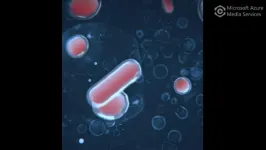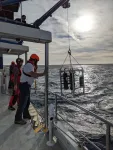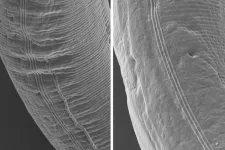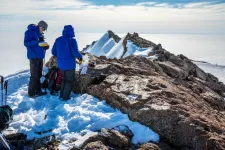(Press-News.org) A recent study in the Journal of Biological Chemistry revealed the key to a protein that commonly causes blindness. The biological process involves a protein that is essential for transporting toxic compounds out of the eye, similar to a garbage recycling service. The challenge is that, like food and the waste it generates, these compounds are essential for the eye to function properly — until they build up and cause blindness.
The scientists behind the study research a protein transporter, called ABCA4, that lines the edges of specialized photoreceptor cells in the retina and is normally poised to remove toxic, fatty retinal byproducts called N-Ret-PE. Retinal is a derivative of vitamin A, which is found in foods such as leafy green vegetables.
“Retinal is critical for vision,” said Robert Molday, a professor of biochemistry and molecular biology at the University of British Columbia who oversaw the work. “But, it's also potentially very toxic because it has a very reactive element. So, cells have to be able to balance between using retinal for sustained vision as well as managing its toxicity .”
Mutations in ABCA4 can cause N-Ret-PE buildup, which leads to vision loss in diseases such as Stargardt disease. Stargardt disease is the most common inherited form of macular degeneration and affects approximately 30,000 people nationwide. There is currently no therapy or cure for the disease.
The researchers were interested in finding out how the ABCA4 transporter malfunctions to cause vision loss. They found that a portion of the protein that interacts with N-Ret-PE, known as the binding pocket, is inert in some patients with Stargardt disease. Therefore, the toxic compounds slip out of the ABCA4 transporter and cannot be removed from the retina.
Next, by changing the makeup of ABCA4, the researchers showed they could mimic the effect of the Stargardt mutations.
“We were able to elucidate the mechanism of binding, which paves the way for treatments for Stargardt disease,” Tongzhou Xu, a postdoctoral fellow at UBC and lead author of the study, said.
The team is optimistic that one day there will be a targeted therapeutic for patients with Stargardt disease that may use gene therapy and specialized particles for delivery to the eye. Gene therapy approaches have already been successfully used to correct mutations in a similar transporter, which causes cystic fibrosis.
“We are now applying two types of technologies to alter ABCA4,” Molday said. “One which was developed to specifically correct the DNA with gene-editing approaches. We are coupling that with lipid nanoparticles, which have been used in the COVID-19 vaccine to encapsulate mRNA. So, by combining these two technologies, we envision being able to potentially correct the defects in individuals with Stargardt's disease that have specific point mutations.”
END
Peering into ocular waste recycling
Researchers uncover a mechanism that causes blindness, could lead to targeted therapies
2023-04-04
ELSE PRESS RELEASES FROM THIS DATE:
Tired of being alone: How social isolation impacts on our energy
2023-04-04
In a study conducted in the lab as well as during the COVID-19 lockdowns, participants reported higher levels of tiredness after eight hours of social isolation. The results suggest that low energy may be a basic human response to a lack of social contact. The study conducted at the University of Vienna and published in Psychological Science also showed that this response was affected by social personality traits of the participants.
If we do not eat for an extended period, a series of biological processes ensue that create a craving sensation we recognize as hunger. As a social species, we also need other people to survive. Evidence shows that a lack of social contact induces ...
Insilico Medicine presents four posters featuring AI-designed anti-cancer drugs at AACR
2023-04-04
Insilico Medicine (“Insilico”), a clinical-stage generative artificial intelligence (AI)-driven drug discovery company, today announced that four abstracts have been accepted as poster presentations at the American Association for Cancer Research (AACR) Annual Meeting 2023.
Insilico will present four novel inhibitors for the treatment of cancer developed with its end-to-end Pharma.AI platform. Drawing from trillions of data points and millions of compounds and molecular fragments, the platform uses ...
FAU developed AUTOHOLO shows potential as red tide warning system
2023-04-04
Red tides, caused by Karenia brevis blooms, are a recurring problem in the coastal Gulf of Mexico. The organism, Karenia brevis, produces toxins that can cause fish kills, respiratory irritation in humans and cause death in sea turtles, dolphins, manatees and birds.
The ability to detect red tide blooms at all life stages and cell concentrations is critical to increasing predictive capabilities and developing potential mitigation strategies to protect public health and vital resources.
Current methods used to monitor red tide such as microscopic identification and enumeration, standard flow cytometry, as well as others have limitations. Some of these ...
Third major accreditation to help OICR Genomics power next generation of precision medicine
2023-04-04
April 4, 2023, TORONTO — Becoming the first genomics lab to be accredited by three of the leading North American accreditation organizations positions OICR Genomics to generate new discoveries about what drives diseases like cancer and new, personalized ways to diagnose and treat them.
The lab earned a Clinical Laboratory Improvement Amendments (CLIA) certificate of accreditation in January 2023 for its whole genome and whole transcriptome sequencing assay, a comprehensive genetic test that can find all changes in the DNA of a tumour. This comes after accreditation from the College of American Pathologists (CAP) in 2021 and from Accreditation Canada Diagnostics (ACD) — ...
Discovery could hold the key to healthy aging during global warming
2023-04-04
SPOKANE, Wash.—Researchers have long known that many animals live longer in colder climates than in warmer climates. New research in C. elegans nematode worms suggests that this phenomenon is tied to a protein found in the nervous system that controls the expression of collagens, the primary building block of skin, bone and connective tissue in many animals.
Since the C. elegans’ protein is similar to nervous system receptor proteins found in other species including humans, the discovery potentially brings scientists closer to finding ways to harness collagen expression to slow down human aging and increase lifespan in the ...
New shape-shifting antibiotics could fight deadly infections
2023-04-04
In the United States alone, drug-resistant bacteria and fungi infect almost 3 million people per year and kill about 35,000. Antibiotics are essential and effective, but in recent years overuse has led to some bacteria developing resistance to them. The infections are so difficult to treat, the World Health Organization deemed antibiotic resistance a top 10 global public health threat.
Now, Professor John E. Moses at Cold Spring Harbor Laboratory (CSHL) has created a new weapon against these drug-resistant ...
The ice in Antarctica has melted before
2023-04-04
Sixty per cent of the world's fresh water is bound up in Antarctic ice sheets. Thirty million cubic kilometres of ice is perhaps a difficult number to grasp. But if absolutely all Antarctica’s ice melted, the seas would rise by 58 metres on average.
“The ice sheet in East Antarctica stores enormous amounts of water. This means that this is the biggest possible source of future sea level rise – up to 53 meters if all of the East Antarctic ice melts – and is seen as the largest source of uncertainties in the ...
Sailing cargo ships can benefit from new aerodynamic tech
2023-04-04
A research team at Chalmers University of Technology is the first to demonstrate a unique method that reduces the aerodynamic resistance of ships by 7.5 per cent. This opens the way for large cargo ships borne across the oceans by wind alone, as wind-powered ships are more affected by aerodynamic drag than fossil-fueled ones.
To hit international climate targets, the carbon emissions from shipping must be reduced by more than 50 per cent by 2050 compared to 2008 levels. As much as 99 per cent of global shipping is currently dependent on fossil fuels. Even though electricity may carry smaller ferries ...
Dozens of brain proteins may play a critical role in body weight regulation
2023-04-04
Québec City, April 4, 2023 – Genetic factors could contribute to up to 50-75% of the variance in body mass index, or BMI, in the population. By analyzing the genome of more than 800,000 people of European descent, a research team from Université Laval and the Quebec Heart and Lung Institute Research Centre has identified 60 unique proteins expressed in the brain that may be critical regulators of body weight.
This study explored the link between genetic regions associated with body weight and the proteins expressed in the brain. "Previous ...
Communication may guide family members’ decisions after sudden cardiac death
2023-04-04
Research Highlights:
Surviving family members of a person who died from sudden cardiac death rely on information from death investigators and health care professionals to process their relative’s death and understand their own risk of inherited heart conditions.
The type and timing of the communication received from death investigators and health care professionals influences family members’ experiences and decisions about whether to pursue genetic screening.
Future research is needed to guide death investigators and health ...
LAST 30 PRESS RELEASES:
An ‘illuminating’ design sheds light on cholesterol
Who is more likely to get long COVID?
Study showcases resilience and rapid growth of “living rocks”
Naval Research Lab diver earns Office of Naval Research 2025 Sailor of the Year
New Mayo-led study establishes practical definition for rapidly progressive dementia
Fossil fuel industry’s “climate false solutions” reinforce its power and aggravate environmental injustice
Researchers reveal bias in a widely used measure of algorithm performance
Alcohol causes cancer. A study from IOCB Prague confirms damage to DNA and shows how cells defend against it
Hidden viruses in wastewater treatment may shape public health risks, study finds
Unlock the power of nature: how biomass can transform climate mitigation
Biochar reshapes hidden soil microbes that capture carbon dioxide in farmland
Reducing saturated fat intake shows mortality benefit, but only in high-risk individuals
Manta rays create mobile ecosystems, study finds
Study: Mixed results in using lipoic acid to treat progressive multiple sclerosis
Norbert Holtkamp appointed director of Fermi National Accelerator Laboratory
New agentic AI platform accelerates advanced optics design
Biologists discover neurons use physical signals — not electricity — to stabilize communication
Researchers discover that a hormone can access the brain by hitchhiking
University of Oklahoma researcher awarded funding to pursue AI-powered material design
Exploring how the visual system recovers following injury
Support for parents with infants at pediatric check-ups leads to better reading and math skills in elementary school
Kids’ behavioral health is a growing share of family health costs
Day & night: Cancer disrupts the brain’s natural rhythm
COVID-19 vaccination significantly reduces risk to pregnant women and baby
The role of vaccination in maternal and perinatal outcomes associated with COVID-19 in pregnancy
Mayo Clinic smartwatch system helps parents shorten and defuse children's severe tantrums early
Behavioral health spending spikes to 40% of all children’s health expenditures, nearly doubling in a decade
Digital cognitive behavioral treatment for generalized anxiety disorder
Expenditures for pediatric behavioral health care over time and estimated family financial burden
Air conditioning in nursing homes and mortality during extreme heat
[Press-News.org] Peering into ocular waste recyclingResearchers uncover a mechanism that causes blindness, could lead to targeted therapies





